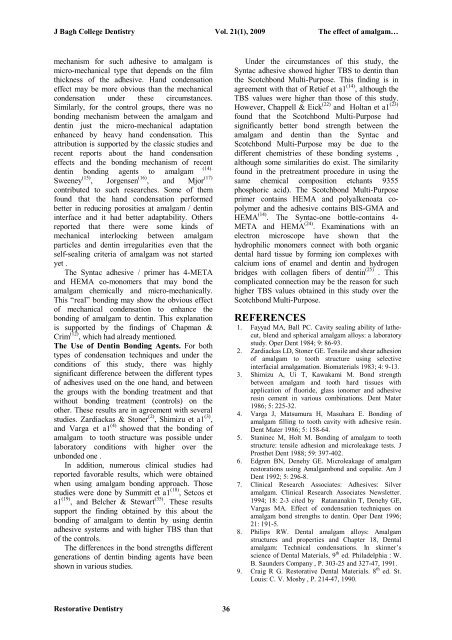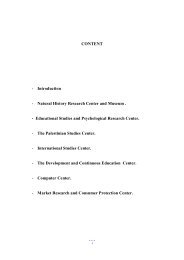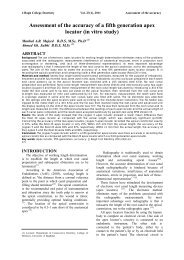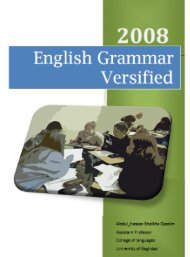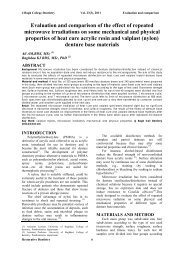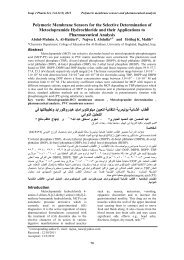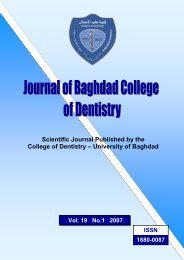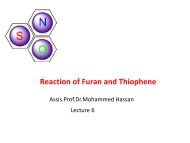Vol 21 No. 1
Vol 21 No. 1
Vol 21 No. 1
You also want an ePaper? Increase the reach of your titles
YUMPU automatically turns print PDFs into web optimized ePapers that Google loves.
J Bagh College Dentistry <strong>Vol</strong>. <strong>21</strong>(1), 2009 The effect of amalgam…<br />
mechanism for such adhesive to amalgam is<br />
micro-mechanical type that depends on the film<br />
thickness of the adhesive. Hand condensation<br />
effect may be more obvious than the mechanical<br />
condensation under these circumstances.<br />
Similarly, for the control groups, there was no<br />
bonding mechanism between the amalgam and<br />
dentin just the micro-mechanical adaptation<br />
enhanced by heavy hand condensation. This<br />
attribution is supported by the classic studies and<br />
recent reports about the hand condensation<br />
effects and the bonding mechanism of recent<br />
dentin bonding agents to amalgam (14).<br />
Sweeney (15) , Jorgensen (16) , and Mjor (17)<br />
contributed to such researches. Some of them<br />
found that the hand condensation performed<br />
better in reducing porosities at amalgam / dentin<br />
interface and it had better adaptability. Others<br />
reported that there were some kinds of<br />
mechanical interlocking between amalgam<br />
particles and dentin irregularities even that the<br />
self-sealing criteria of amalgam was not started<br />
yet .<br />
The Syntac adhesive / primer has 4-META<br />
and HEMA co-monomers that may bond the<br />
amalgam chemically and micro-mechanically.<br />
This “real” bonding may show the obvious effect<br />
of mechanical condensation to enhance the<br />
bonding of amalgam to dentin. This explanation<br />
is supported by the findings of Chapman &<br />
Crim (12) , which had already mentioned.<br />
The Use of Dentin Bonding Agents. For both<br />
types of condensation techniques and under the<br />
conditions of this study, there was highly<br />
significant difference between the different types<br />
of adhesives used on the one hand, and between<br />
the groups with the bonding treatment and that<br />
without bonding treatment (controls) on the<br />
other. These results are in agreement with several<br />
studies. Zardiackas & Stoner (2) , Shimizu et a1 (3) ,<br />
and Varga et a1 (4) showed that the bonding of<br />
amalgam to tooth structure was possible under<br />
laboratory conditions with higher over the<br />
unbonded one .<br />
In addition, numerous clinical studies had<br />
reported favorable results, which were obtained<br />
when using amalgam bonding approach. Those<br />
studies were done by Summitt et a1 (18) , Setcos et<br />
a1 (19) , and Belcher & Stewart (35) . These results<br />
support the finding obtained by this about the<br />
bonding of amalgam to dentin by using dentin<br />
adhesive systems and with higher TBS than that<br />
of the controls.<br />
The differences in the bond strengths different<br />
generations of dentin binding agents have been<br />
shown in various studies.<br />
Under the circumstances of this study, the<br />
Syntac adhesive showed higher TBS to dentin than<br />
the Scotchbond Multi-Purpose. This finding is in<br />
agreement with that of Retief et a1 (14) , although the<br />
TBS values were higher than those of this study.<br />
However, Chappell & Eick (22) and Holtan et a1 (23)<br />
found that the Scotchbond Multi-Purpose had<br />
significantly better bond strength between the<br />
amalgam and dentin than the Syntac and<br />
Scotchbond Multi-Purpose may be due to the<br />
different chemistries of these bonding systems ,<br />
although some similarities do exist. The similarity<br />
found in the pretreatment procedure in using the<br />
same chemical composition etchants 9355<br />
phosphoric acid). The Scotchbond Multi-Purpose<br />
primer contains HEMA and polyalkenoata copolymer<br />
and the adhesive contains BIS-GMA and<br />
HEMA (14) . The Syntac-one bottle-contains 4-<br />
META and HEMA (24) . Examinations with an<br />
electron microscope have shown that the<br />
hydrophilic monomers connect with both organic<br />
dental hard tissue by forming ion complexes with<br />
calcium ions of enamel and dentin and hydrogen<br />
bridges with collagen fibers of dentin (25) . This<br />
complicated connection may be the reason for such<br />
higher TBS values obtained in this study over the<br />
Scotchbond Multi-Purpose.<br />
REFERENCES<br />
1. Fayyad MA, Ball PC. Cavity sealing ability of lathecut,<br />
blend and spherical amalgam alloys: a laboratory<br />
study. Oper Dent 1984; 9: 86-93.<br />
2. Zardiackas LD, Stoner GE. Tensile and shear adhesion<br />
of amalgam to tooth structure using selective<br />
interfacial amalgamation. Biomaterials 1983; 4: 9-13.<br />
3. Shimizu A, Ui T, Kawakami M. Bond strength<br />
between amalgam and tooth hard tissues with<br />
application of fluoride, glass ionomer and adhesive<br />
resin cement in various combinations. Dent Mater<br />
1986; 5: 225-32.<br />
4. Varga J, Matsumura H, Masuhara E. Bonding of<br />
amalgam filling to tooth cavity with adhesive resin.<br />
Dent Mater 1986; 5: 158-64.<br />
5. Staninec M, Holt M. Bonding of amalgam to tooth<br />
structure: tensile adhesion and microleakage tests. J<br />
Prosthet Dent 1988; 59: 397-402.<br />
6. Edgren BN, Denehy GE. Microleakage of amalgam<br />
restorations using Amalgambond and copalite. Am J<br />
Dent 1992; 5: 296-8.<br />
7. Clinical Research Associates: Adhesives: Silver<br />
amalgam. Clinical Research Associates Newsletter.<br />
1994; 18: 2-3 cited by Ratananakin T, Denehy GE,<br />
Vargas MA. Effect of condensation techniques on<br />
amalgam bond strengths to dentin. Oper Dent 1996;<br />
<strong>21</strong>: 191-5.<br />
8. Philips RW. Dental amalgam alloys: Amalgam<br />
structures and properties and Chapter 18, Dental<br />
amalgam: Technical condensations. In skinner’s<br />
science of Dental Materials, 9 th ed. Philadelphia : W.<br />
B. Saunders Company , P. 303-25 and 327-47, 1991.<br />
9. Craig R G. Restorative Dental Materials. 8 th ed. St.<br />
Louis: C. V. Mosby , P. <strong>21</strong>4-47, 1990.<br />
Restorative Dentistry 36


